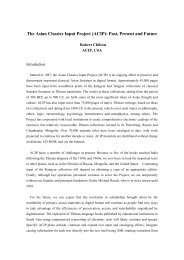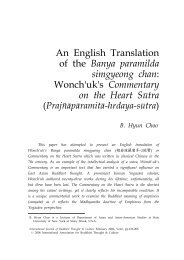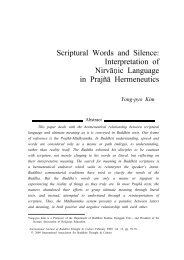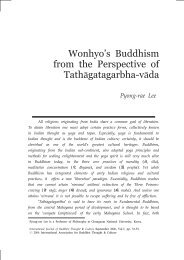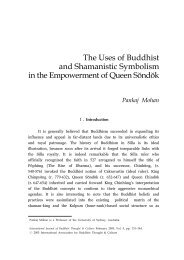Esoteric Buddhism under the KoryÅ in the Light of ... - Buddhism.org
Esoteric Buddhism under the KoryÅ in the Light of ... - Buddhism.org
Esoteric Buddhism under the KoryÅ in the Light of ... - Buddhism.org
You also want an ePaper? Increase the reach of your titles
YUMPU automatically turns print PDFs into web optimized ePapers that Google loves.
International Journal <strong>of</strong> Buddhist Thought & Culture 59<br />
acceptance <strong>in</strong> Ch<strong>in</strong>a, where it blended with certa<strong>in</strong> elements <strong>of</strong> Daoist<br />
practice and lore from early on. 4 And what is perhaps <strong>the</strong> most<br />
<strong>in</strong>terest<strong>in</strong>g th<strong>in</strong>g to note here, is <strong>the</strong> fact that <strong>the</strong> Ch<strong>in</strong>ese Buddhist<br />
canon has ma<strong>in</strong>ta<strong>in</strong>ed and perpetuated early <strong>Esoteric</strong> Buddhist texts<br />
which have long s<strong>in</strong>ce been lost <strong>in</strong> India. Historically this has meant<br />
that ancient <strong>Esoteric</strong> Buddhist scriptures and d2ra!is have cont<strong>in</strong>ued to<br />
<strong>in</strong>form <strong>the</strong> East Asian Buddhist tradition up through <strong>the</strong> centuries,<br />
whereas this material is to a large extent absent from <strong>the</strong> Indo-Tibetan<br />
tradition. From this perspective it is possible to argue - if we detract<br />
<strong>the</strong> <strong>in</strong>digenous S<strong>in</strong>itic elements that have crept <strong>in</strong>to many texts as well<br />
as <strong>the</strong> apocrypha - that <strong>the</strong> <strong>Esoteric</strong> Buddhist tradition <strong>in</strong> East Asia,<br />
that <strong>of</strong> Ch<strong>in</strong>a <strong>in</strong> particular, is by far <strong>the</strong> oldest representative <strong>of</strong> Indian<br />
<strong>Esoteric</strong> <strong>Buddhism</strong> <strong>of</strong> <strong>the</strong> pre-Gupta period.<br />
The formal systematization <strong>of</strong> <strong>Esoteric</strong> <strong>Buddhism</strong> <strong>in</strong> Ch<strong>in</strong>a did not<br />
come about before <strong>the</strong> mid-Tang (8th cent.) <strong>in</strong> <strong>the</strong> form <strong>of</strong> <strong>the</strong> Zhenyan<br />
School 眞 言 宗 . 5 Some scholars have described this development as <strong>the</strong><br />
first systematization <strong>of</strong> Tantric <strong>Buddhism</strong>, however, I have found little<br />
direct connection between it and <strong>the</strong> Indo-Tibetan Buddhist Tantras -<br />
ritually as well as doctr<strong>in</strong>ally - except that both traditions endorse deity<br />
identification and ritual practices as <strong>the</strong> path to enlightenment. 6 In <strong>the</strong><br />
early 9th century <strong>the</strong> Zhenyan School was formally <strong>in</strong>troduced to Japan<br />
and possible Korea as well. The Huichang Suppression <strong>of</strong> <strong>Buddhism</strong><br />
(845-6 A.D.) which destroyed most <strong>of</strong> <strong>the</strong> established schools <strong>of</strong><br />
<strong>Buddhism</strong> <strong>in</strong> <strong>the</strong> central prov<strong>in</strong>ces, dealt a death-blow to <strong>the</strong> Zhenyan<br />
School which ceased to exist as a separate denom<strong>in</strong>ation <strong>of</strong> Ch<strong>in</strong>ese<br />
<strong>Buddhism</strong>. However, despite this significant setback, <strong>Esoteric</strong> <strong>Buddhism</strong><br />
4 This <strong>in</strong>terest<strong>in</strong>g development is aptly treated by Strickmann (1996; 2002). For a review article<br />
on <strong>the</strong> latter, see Sørensen (2004a).<br />
5 One may argue whe<strong>the</strong>r this name is historically appropriate. Never<strong>the</strong>less, I believe that <strong>the</strong>re<br />
is sufficiently evidence to see <strong>the</strong> activities <strong>of</strong> <strong>the</strong> four 2c2ryas $ubh2karasi8ha, Vajrabodhi<br />
(669-741), Amoghavajra (705-774) and Huiguo 惠 果 (?-805) as be<strong>in</strong>g both historically, doctr<strong>in</strong>ally<br />
and <strong>in</strong>stitutionally l<strong>in</strong>ked. Moreover, <strong>the</strong> <strong>Esoteric</strong> Buddhist traditions <strong>of</strong> <strong>the</strong> 9th century,<br />
<strong>in</strong>clud<strong>in</strong>g those <strong>of</strong> Tang, Heian and Silla, certa<strong>in</strong>ly saw <strong>the</strong>se 2c2ryas as constitut<strong>in</strong>g a l<strong>in</strong>eage,<br />
or ra<strong>the</strong>r l<strong>in</strong>eages <strong>of</strong> Buddhist transmission.<br />
6 See <strong>the</strong> discussion <strong>in</strong> Orzech (1989).



